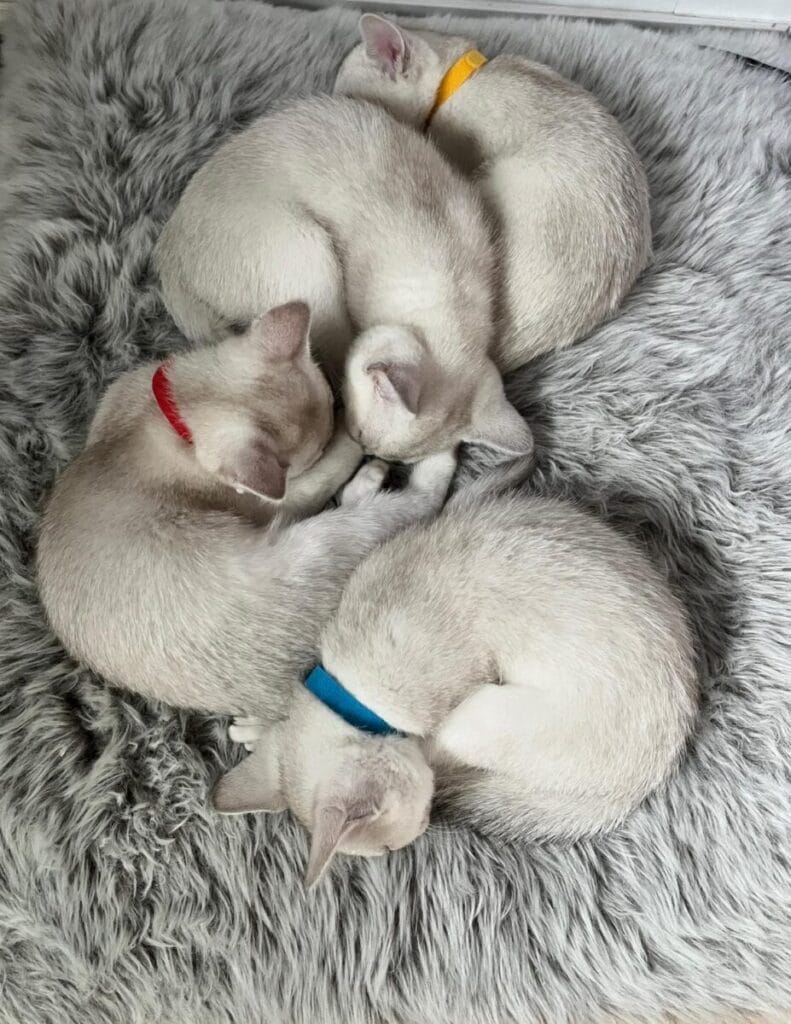The Burmilla cat was first developed in 1981 by a British Shorthair breeder named Miranda Von Kirchberg. She wanted to create a shorthair cat with the Burmese temperament and the Persian’s silky coat. By crossing a Lilac Burmese with a Chinchilla Persian, the first kitten was born. This hybrid cat combined the gentle, playful personality of the Burmese with the plush, shimmery fur of the Persian.
Introduction The Burmilla Cat Breed
The Burmilla is a medium-sized breed with a muscular yet elegant body structure. These cats typically weigh between 6-10 lbs when fully grown. Their coat is short to medium in length, soft, and silky. Come in a range of colors like black, blue, chocolate, lilac, red, cream, brown, and silver. They have expressive green or yellow eyes that give them a sweet expression.

Affectionate with Family: ⭐⭐⭐⭐
Amount of Shedding: ⭐⭐
General Health: ⭐⭐⭐
Potential for Playfulness: ⭐⭐⭐⭐
Tendency to Vocalize: ⭐⭐
Kid-Friendly: ⭐⭐⭐⭐
Friendly Toward Strangers: ⭐⭐⭐
Easy to Groom: ⭐⭐⭐
Intelligence: ⭐⭐⭐
Pet Friendly: ⭐⭐⭐
- Appearance: Have a medium muscular build, round head, large ears, and expressive almond-shaped eyes. Their coat is short to medium length, fine, silky, and shimmery.
- Characteristics: Intelligent, playful, affectionate, vocal at times, kid and pet-friendly.
- Popularity: Gaining popularity but still quite rare. There are an estimated 300-500 worldwide.
- Temperament: Gentle, social, smart, moderately active, enjoys human interaction. Good with children and other pets.
- Lifespan: 12-16 years.
- Coat Color: Black, blue, chocolate, lilac, red, cream, brown, silver. Silver is the most common.
- Origins: Hybrid between the Burmese and Persian breeds.
How to Care for a Burmilla Cat Breed
Food:
- High-quality dry cat food formulated for their age and activity level. Provide constant access to fresh water.
- Feed scheduled meals rather than free-feeding to prevent obesity. Burmillas love food and will overeat!
- High protein cat foods with meat as the first ingredient. Chicken, turkey, lamb, beef are great options.
Environment:
- Safe, clean home environment free of toxins and hazards. Provide scratching posts.
- Burmillas are adaptable but prefer a moderately active household. They enjoy play time each day.
- Access to sunny windows, cozy beds, scratching posts. Keep litter boxes clean.
Grooming:
- Brush coat weekly to reduce shedding and matting. Trim nails every 2-3 weeks.
- Burmilla coats are low maintenance. Their silky fur rarely tangles or mats.
- Check ears weekly for dirt buildup. Clean gently with cotton ball soaked in mineral oil.
- Reward good behavior during grooming. Make it a calm, positive experience.

Take Care Method: Provide interactive playtime daily using feather wands, laser toys, balls to engage their natural hunting instincts. Puzzle feeders with treats keep them mentally stimulated.
How to Adopt/Buy a Burmilla Cat
- Locations of Popularity: Burmillas are still quite rare globally. Most breeders are located in Europe, especially the UK. Some can be found in North America and Australia.
- Average Price: $600 to over $1000 USD depending on breeder reputation and cat’s pedigree.
- Adoption/Rescue: Check pet adoption sites like PetFinder for available Burmilla rescues. Look for Burmilla cat rescues in your area.
What to Check Before Adopting/Buying:
- General Health: Healthy weight, clear eyes/nose, clean teeth/ears, active & alert.
- Vaccine Status: Up to date on all age-appropriate vaccines like FVRCP, rabies.
- Medical History: Review vet records for any prior illness or hereditary conditions.
Preparing for a Burmilla Cat
- Childproof your home by securing cords, toxic chemicals, and other hazards.
- Stock up on cat food, litter, scratching posts, safe toys to occupy their energy.
- Find a trusted vet and schedule a wellness exam soon after adoption.
- Provide stimulating playtime and affection daily to meet their social needs.
- Set up cozy lounging areas near sunny windows. Offer comfy cat beds.
Equipment:
- Quality scratching posts, cat trees, beds
- Interactive wand toys, treat puzzles, feather teasers
- Ceramic or stainless steel food and water bowls
- Litter box, scoop, cat-safe litter

Common Diseases:
- Hypertrophic cardiomyopathy: Causes thickened heart walls. Detected via ultrasound.
- Gingivitis: Inflammation of the gums. Prevent through dental care.
- Urinary tract infections: More common in males. Signs include frequent urination and blood in urine.
Recommended Vaccines:
- FVRCP (rhinotracheitis, calici, panleukopenia viruses)
- Rabies
- Feline leukemia virus
Naming Your Burmilla
Choose a friendly, upbeat name that suits your cat’s personality. Avoid names that sound like negative commands. Consider food names, nature names, or quirky human names. Some examples: Peaches, Luna, socks, Oreo, Lulu, Ash, Basil, Finn.
Do Burmilla cats like going outside rather than staying indoors?
Cats can adapt to indoor or outdoor living but are safest kept indoors where no threats exist. Provide interactive playtime daily.
Are Burmilla cats smart?
Yes, Cats are highly intelligent and can learn tricks, walk on leashes, and solve treat puzzles. Engage their minds through training and games.
How many types of Burmilla cats are there?
There are longhair and shorthair varieties. Shorthair Burmillas are more common. Coat colors include silver, brown, blue, chocolate, lilac, red.
How to stop a cat from biting?
Redirect biting onto appropriate chew toys. Say “no” firmly and ignore them after biting. Reward gentle play. Consider deterrent sprays.
How to stop a cat from scratching?
Provide plenty of scratching posts. Praise them for using scratchers. Clip nails regularly. Use double-sided tape on furniture.
How to socialize and raise a friendly Burmilla cat?
Expose kittens to new sights, sounds, people positively. Reward calm, friendly behavior. Gently handle paws, ears, mouth in play.
How to train?
Use rewards like treats, praise. Stay positive. Use clicker training. Practice basic commands like sit, stay, come. Use target sticks.
How often should Burmilla cats see the vet?
Annual exams are recommended. Senior cats over 8 years old should visit the vet twice yearly. Monitor for any changes.
Are cats good family pets?
Yes, Burmillas tend to be very affectionate and gentle family companions. Supervise young kids and properly introduce any other pets.
Are Burmilla cats good with children?
Generally yes, especially if raised with kids. Always supervise interactions. Teach children how to gently handle cats.
Are Burmilla cats good with other animals?
Burmillas usually coexist well with other pets if properly introduced. Their playful nature may require monitoring with smaller pets.
Can Burmilla cats cause allergies?
Burmillas shed moderately. Allergens are found in saliva and skin oils too. Speak to your doctor before adopting if you have allergies.
Are Burmilla cats ferocious?
No, Burmillas have a very gentle, friendly temperament. They may play-bite on occasion but are not typically aggressive.
Do Burmilla cats have hair loss problems?
No, Burmilla coats are generally easy to maintain and shed minimally. Hair loss can signal an underlying medical issue so see your vet.
Are you a cat lover who wants to learn more about your furry friends? Do you want to find the best cat food, cat care tips, and resources for your cats? If so, you’ve come to the right place! Welcome to Cat Food Site, the ultimate website for cat enthusiast.
Here you will find everything you need to know about cats Breed, from their health and behavior to their breeds, cat diet and names. You will also discover the latest cat news, cat nutrition, trends, and memes from around the web.

